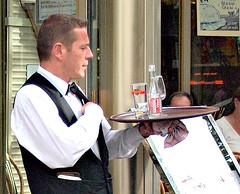 Restaurants have a few advantages when it comes to customer service. Unlike in many industries, restaurant employees have the chance to interact personally with customers. This means restaurants have more opportunities to deliver a positive emotional experience to each guest. On the other hand, because it’s such a guest-focused industry, the bar for outstanding customer service is set a little higher in the restaurant arena. Therefore, restaurant managers and owners have more motivation to identify and replicate employee effort that engages and delights customers.
Restaurants have a few advantages when it comes to customer service. Unlike in many industries, restaurant employees have the chance to interact personally with customers. This means restaurants have more opportunities to deliver a positive emotional experience to each guest. On the other hand, because it’s such a guest-focused industry, the bar for outstanding customer service is set a little higher in the restaurant arena. Therefore, restaurant managers and owners have more motivation to identify and replicate employee effort that engages and delights customers.
In this article, we’ll examine the general customer service landscape in the restaurant sector. Next, we’ll take a look at the characteristics all businesses must exhibit in order to win high Customer Engagement, as our 2010 Most Engaged Customers (MEC) report revealed. Finally, we’ll zoom in on the “hot button” issues for customer engagement in the restaurant space.
PeopleMetrics found a 51% engagement rate among customers in all industries. However, if we limit the focus to only the restaurant sector, we find that 61% of customers are engaged. This implies that restaurant customers generally receive better service, perhaps because this is one of the last industries in which face-time is still common. However, once we break down those statistics according to each brand, we see a wider spectrum of scores, from 51% for McCormick & Schmicks, to 67% for Ruth’s Chris. In other words, some restaurants are more successful than others at creating a compelling customer experience.
What sets apart organizations with high Customer Engagement scores? What do they know about how to improve customer satisfaction? Well, it starts with a compelling business offer. Additionally, restaurants, like all organizations, must display consistent customer care that earns their customers’ trust. Extraordinary, authentic employee effort is also key to engaging customers. These are the traits PeopleMetrics has found influences Customer Engagement, which in turn impacts such important business outcomes such as profit margins, share price, and ROI. (To learn more about these six traits for Customer Engagement, read our blog post, “Why the Ritz-Carlton is #1 in Customer Engagement.”)
We have discovered a few “hot button” issues for restaurateurs, namely the business offer, consistency, customer care, and employee effort. The compelling business offer at a restaurant might be superior food quality. One Ruth's Chris guest gave insightful customer satisfaction feedback on the brand's business offer, explaining, “There are no words to describe how good their steaks are. I don’t even want to try. And the desserts are heavenly.” A wide variety of menu choices and an enjoyable atmosphere are also viable business offers.
The most critical trait in the restaurant space is extraordinary extra effort from restaurant employees. As one Cheesecake Factory respondent put it, “They do everything in their power to make certain you have an outstanding time when eating in the restaurant. The staff is always helpful and friendly. They always seem to go above and beyond to make sure that everything is just right.” We have found that Engaged Employees foster engagement among customers as well. Some chains, such as Texas Roadhouse, engage employees through fun activities, including nightly in-house competitions and line dances in the dining room. Each restaurant is unique, so a strong Customer Engagement strategy begins with Employee Engagement research to determine what motivates employees. Ultimately, attentive, consistent, authentic service is what sets apart the restaurants with the most engaged customers.
[photo: Zoetnet]
Topic: Customer Experience





%20(1).png)